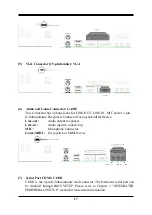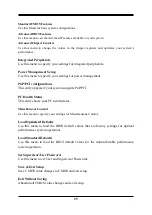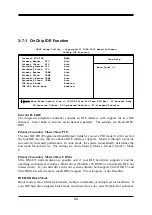
is working
System running at a lower frequency
6. During power-on, press <Delete> key to enter BIOS setup. Follow the instructions
in BIOS SETUP.
7.
Power off your computer:
You must first exit or shut down your operating
system before switch off the power switch. For ATX power supply, you can press
ATX power switching after exiting or shutting down your operating system. If you
use Windows 9X, click
“Start”
button, click
“Shut down”
and then click
“Shut
down the computer?”
The power supply should turn off after windows shut
down.
Chapter 3
Introducing BIOS
The BIOS is a program located on a Flash Memory on the motherboard. This program
is a bridge between motherboard and operating system. When you start the computer,
the BIOS program gain control. The BIOS first operates an auto-diagnostic test called
POST (power on self test) for all the necessary hardware, it detects the entire hardware
device and configures the parameters of the hardware synchronization. Only when
these tasks are completed done it gives up control of the computer to operating system
(OS). Since the BIOS is the only channel for hardware and software to communicate,
it is the key factor for system stability, and in ensuring that your system performance
as its best.
In the BIOS Setup main menu of Figure 3-1, you can see several options. We will
explain these options step by step in the following pages of this chapter, but let us first
see a short description of the function keys you may use here:
Press <Esc> to quit the BIOS Setup.
Press
(up, down, left, right) to choose, in the main menu, the option you
want to confirm or to modify.
Press <F10> when you have completed the setup of BIOS parameters to save
these parameters and to exit the BIOS Setup menu.
Press Page Up/Page Down or +/
–
keys when you want to modify the BIOS
parameters for the active option.
3-1 Entering Setup
Power on the computer and by pressing <Del> immediately allows you to enter Setup.
23
















































